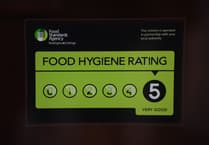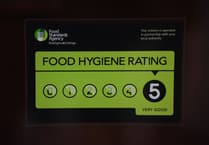OBJECTORS to plans to relocate the access road to serve up to 135 proposed new homes at Sturt Farm, protested it would be “ruinous” at Haslemere Town Council last Thursday.
Concise Construction’s project manager Ian Rhodes came under fire after briefing planning committee members on a revised application to change the route so it uses the existing access to a cluster of grade II listed buildings at the farm.
The application also proposes providing nine acres of farmland to be used as suitable alternative natural green space (SANG) to serve the development, which got outline consent in 2015, in an area of outstanding natural beauty.
The latest plan follows two previous ‘hybrid’ applications that included re-routing the road so it runs past the four dwellings, both of which were withdrawn following an outcry.
So far the application has triggered 52 objections and two letters of support.
The supporting design and access statement said a heritage impact assessment demonstrated the improved access would have no impact on the fabric of the listed buildings and, when compared with the consented access, demonstrated “a low beneficial impact”.
It stated the alternative access through Sturt Farm also improved the ecological credentials of the scheme already consented, by reducing the extent of hard landscape, reducing the extent of excavation and demolition of retaining walls and increasing the landscaping opportunities.
The document concluded the proposals would not have any “material impact on the living conditions of the neighbouring residents” and the access road was appropriate in terms of its design and impact on the environment – and would provide appropriate and safe access to vehicles, pedestrians and cyclists.
Urging the town council to support the scheme, Mr Rhodes said: “The main advantage is it doesn’t disrupt the existing layout and landscape. An issue has been possible impact on listed buildings, but the consented scheme would mean no privacy to the rear of the buildings. Two experts were appointed by us and their revised proposals are much better.
“An accusation has been made this is proposed to save money. That’s true, in part, but we genuinely believe this is better.
“It will be a better development at Sturt Farm if we get as near to 135 houses as we can, and as many affordable as we can. If we don’t get this route agreed, the number of affordable homes is compromised. We are proposing to build 40 per cent affordable, which is better than Waverley’s 30 per cent.”
Calling on the town council to oppose the plan, Sturt Farm resident Mark Eldridge said: “This represents a complete reversal of the original plan granted outline acceptance on the understanding that the setting of the track would reman undisturbed.
“How can the routing of a modern highway and wide footpath through historic buildings be more acceptable than the route approved.
“I work from Lower Barn as a musician and the traffic noise will make it impossible to record music, as the road will be inches away from a listed building. I also think my livelihood should be taken into account.
“Some 600 cars will use the road. The setting does not need to be ruined for the development to go ahead.”
Agreeing, town and borough councillor Jim Edwards said: “I really don’t think we can view this in any other way than an intrusion onto a listed setting.
“Getting consent for the development was very controversial. Now they come back again to try and get a more economical access.
“I can understand why they have done it, but it’s a beautiful listed setting and I think we should keep it.”
Fellow town and borough councillor Libby Piper told the meeting she understood the applicants didn’t want to have to drill through a retaining wall but added: “To put a road through the middle of these buildings will have a significant effect on their amenity. Even if there are 120 or 135 houses, it’s just going to make it like a brightly lit street and that’s not acceptable.
Reiterating housing numbers would go down if the route didn’t change, Mr Rhodes said: “The existing access is in the wrong place so we would lose units.”
Mr Edwards objected Mr Rhodes had been given more than his allocated five minutes to make the points he wanted to make and called for councillors to make a decision on how to respond to Waverley.
It was agreed, the town council would recommend the application was rejected on the grounds it was contrary to Waverley’s 2002 Local Plan, as it would have a detrimental impact on heritage and listed buildings.
• Waverley’s decision to grant outline planning consent for 1,800 houses at Dunsfold Park will now be subject to a judicial review as well as a planning inquiry.
The Protect Our Waverley campaign group has had its application for a judicial review into the way the Dunsfold Park planning application was resolved, approved by the High Court.
The application will now proceed as a full judicial review hearing. It will be held as soon as possible after June 20 – and before the Dunsfold Park public inquiry opens on July 18, in order for a decision to be reached before the inquiry begins.
The judicial review announcement is a further upset to Waverley’s hopes of getting its Draft Local Plan adopted. Being allowed to build up to 2,600 new homes at the airfield is the cornerstone of how it will meet government targets to build 10,000 new homes by 2032



Comments
This article has no comments yet. Be the first to leave a comment.